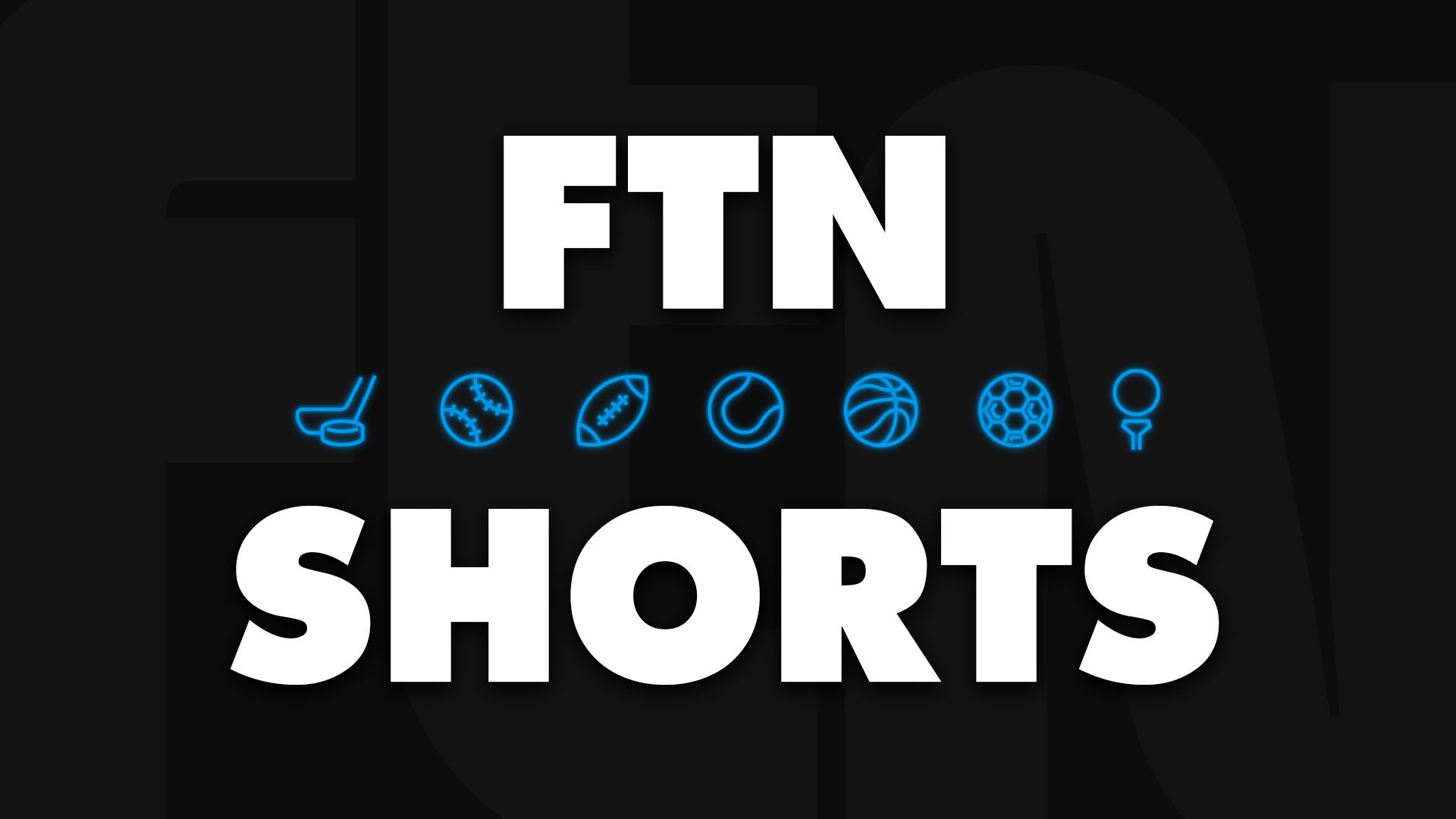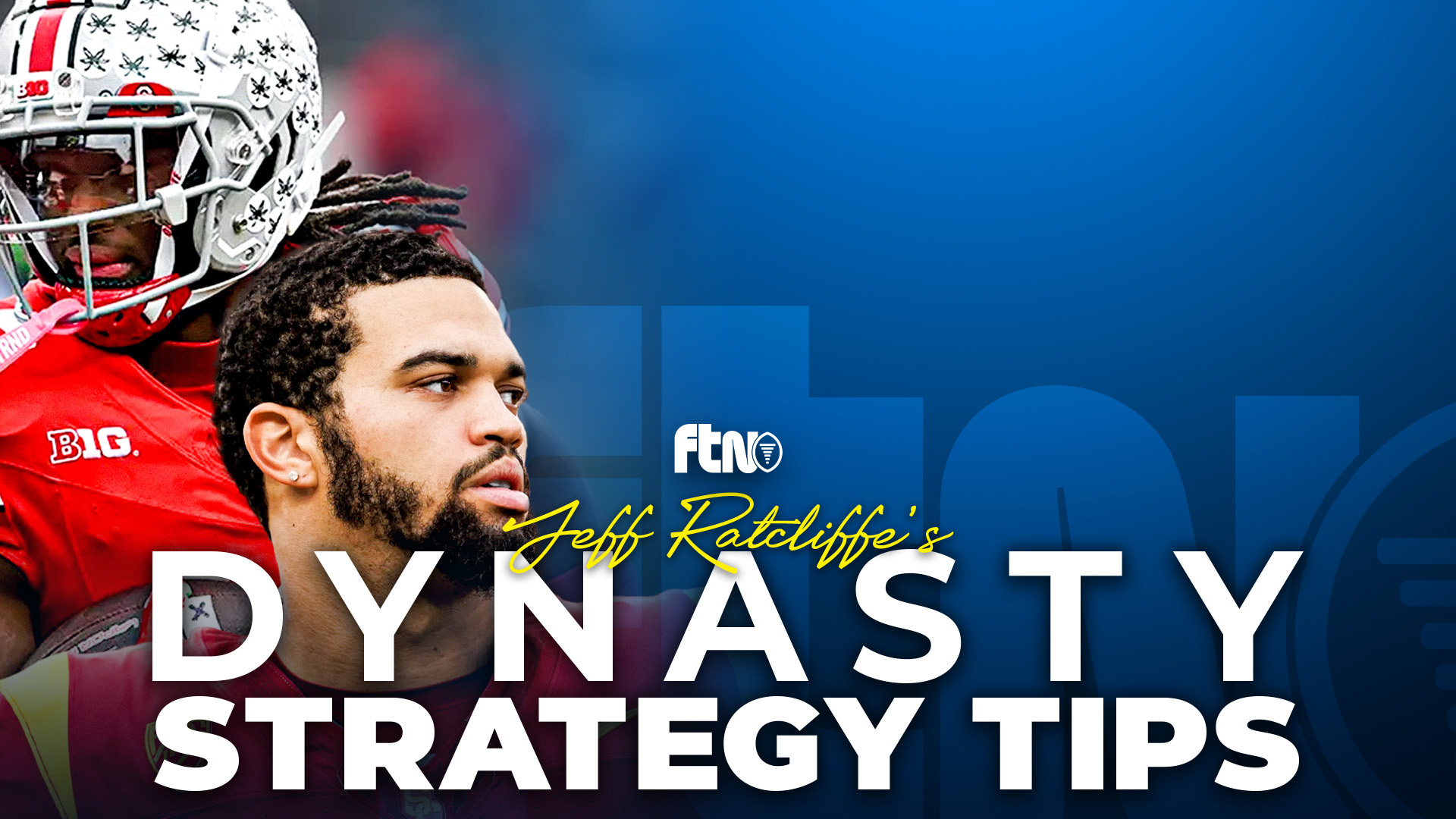










Dynasty leagues are a growing subset of fantasy football that presents a unique set of challenges that you don’t face in regular redraft leagues. How does dynasty draft strategy differ redraft leagues when you have a startup draft? What are the most important factors to consider when making trades? How can you maximize potential in your annual rookie drafts?
These are some of the most important areas for dynasty roster building and management. To help you with these questions, I put together the following five dynasty fantasy football strategy tips.
We don’t need to overthink draft strategy in dynasty startup drafts. Our goal is to build a roster that will be competitive not only in Year 1 but going forward through the first 3-5 years of the league. We only get one chance at this, so we must make the most of our startup draft.
In my startups, I use a very traditional value-based approach where I’m drafting the best player on the board when I’m up over the first five rounds of the draft. That means no reaching. Reaching is the enemy in fantasy drafts. When we reach, we draft a player ahead of where we value him. That means not only are we overpaying, but we’re also letting higher-value players slip down the board to our opponents. That’s losing fantasy football right there.
From there, I will adjust my picks based on the existing roster I’ve built to that point in the draft. For example, if I went with five wide receivers in a row to start the draft, I’d likely look to either running back or wide receiver in the sixth round even if a wide receiver is the top player on my board.
To determine value, I use a set of rankings. My preference is to use my own, but any set of rankings you trust will suffice. Just as an aside, it’s important to note that I build my dynasty rankings for startup drafts. They don’t have utility beyond startup drafts for things like waivers or trades. But we’ll get into trades later.
Now, the most important step I take before my draft is eliminating older players from my rankings. My goal is to draft no older than 25 at running back, 27 at wide receiver, 29 at tight end and 32 at quarterback. So, before I draft, I simply cross players off my rankings who do not meet those age requirements. That means someone like Tyreek Hill, who is WR17 in my rankings at the time of this writing, will be crossed off and I will not draft him. You might ask why I decide to rank a player I won’t draft? I realize that my approach won’t work for everyone, so I will rank all players regardless of whether I will draft them.
The No. 1 mistake I see people who are new to dynasty make in their startup drafts is trading away startup picks for Year 1 rookie draft picks. Don’t get me wrong — rookie picks are important over the life of your dynasty roster, but as I said above, we only get one chance to build the foundation of our roster in our startup draft. Therefore, it’s vital we make all our startup picks.
In fact, doing the opposite of the masses is a more optimal move. Look to leverage your Year 1 rookie draft picks and turn them into more picks in your startup draft. Sure, on the surface, trading a first-round rookie pick for an eighth-round startup pick may sound lopsided against you, but it’s really the reverse. That eighth-round pick could end up being a long-term fantasy starter for you. And unlike a rookie draft, you’re likely selecting a proven commodity in your startup draft.
Again, rookie draft picks are going to end up being very important over the long haul, but you shouldn’t need to refill your coffers after the first year of the league. So, if there’s a time to trade those Year 1 rookie picks away, it’s during your startup draft.
Unlike in 1QB leagues, you can’t get away with waiting at quarterback in superflex formats. However, you also don’t need to draft the position in Round 1 to be competitive. Sure, having Josh Allen is great, but you can easily make up ground at the position if you zig while others zag and draft non-quarterbacks in the beginning of your drafts. It’s going to be much more difficult for your opponents to make up ground on you at wide receiver or running back.
But when do we start drafting quarterbacks in a superflex startups? There isn’t a simple answer like “Round 3,” because there’s significantly more variation in superflex drafts than we see in 1QB formats. Sometimes, quarterbacks fly off the board. Other times, they hang around for a while. I’ve found the best way to determine when we should draft the position is by waiting for at least a certain amount of signal callers to be selected.
In redraft, I use the very easy to remember “at least 10 quarterbacks” rule. That means we wait until at least 10 are off the board, and then we pounce, drafting two in back-to-back rounds. I then grab my third after at least 24 are drafted. For dynasty startups, we need to adjust this strategy slightly because some quarterbacks won’t be draftable due to age. Guys like Aaron Rodgers have already been crossed off our board.
With the older quarterbacks crossed off, we need to determine how many draftable quarterbacks are starters. In 2024, we have 26 starters who are 32 or younger. However, five of them are rookies this year. Rookies may not be in your startup pool. If they aren’t, take them off the list of starters. From there, we want to address the position when roughly half the list has been drafted. So, this year that would be after a dozen quarterbacks drafted if we’re including rookies and after 10 are drafted if we aren’t. Like the redraft strategy, we’ll want to immediately draft two quarterbacks in back-to-back rounds. We’ll then want to draft our third after 24 have been selected.
One of the most common questions I get about managing a dynasty roster is when we should trade players away. It’s an important consideration, because there’s eventually a point in every player’s career where his dynasty trade value evaporates. If we can’t trade an older player away, we’re essentially in a doomsday scenario where we’ll eventually have to cut that player. When we cut players in dynasty, we replace them with waiver adds. The chances of one of those waiver adds becoming a viable fantasy option are very slim.
Instead, the goal is to move players at the right time and ideally get picks or younger players in exchange. That way, we’re constantly resetting the clock on our roster. Failing to do so once or twice is going to happen. However, failing to do so consistently will lead us on a crash course towards a rebuild. Having rebuilt a dynasty roster or two in the past, I can tell you it sucks. Rebuilds don’t last a season. They can last several years where often there’s seemingly no light at the end of the tunnel. It’s no surprise that rebuilds are the No. 1 reason why dynasty rosters get orphaned.
Before discussing when we should trade players away, it’s important to note there’s only one reason to make trades in any fantasy football format: to make your team better. If a trade doesn’t make your team better, don’t do the trade. It doesn’t matter if your side of the trade “won” the trade if you made a move that didn’t help your team. In dynasty, the top way to make our team better is by cycling out older players and replacing them with younger players or rookie pick assets.
The best way to avoid rebuilds is trading away players at the right time, and to determine that time, I’ve developed the dynasty criteria. This is a combination of age and seasons played for running backs and wide receivers. When the player reaches at least one of the criteria, it’s time to move on from that player. From running backs it’s: age-26 season and/or five seasons played. For wide receivers it’s: age-29 season and/or eight seasons played.
Do I have criteria for quarterbacks or tight ends? No. Quarterbacks have such a lengthy shelf life that good ones could be on your roster for 15 years. They’re the opposite of running backs in that regard. As for tight ends, the position is still so thin that if I get a good one, I will run him into the ground. This could change in the future if there’s a continued influx of talent at the position, but for now, there is no criteria at tight end.
When a player reaches criteria, it’s time to move on from him. This could be hard to do. Case in point: Cooper Kupp in 2021. He was coming off one of the greatest wide receiver seasons in NFL history, but he was also entering his age-29 season. If you unloaded him before 2022, you made out like a bandit. His value will likely never approach that point again. Of course, this is a perfectly timed example, and they won’t all be so cut-and-dry. But the point of criteria is to give us an optimal range to look to trade away running backs and wide receivers, since none of us have a crystal ball that can accurately measure where the peak of a player’s career will occur.
In terms of compensation, ideally, we get a pick or multiple picks in exchange for the player. The picks should be for the current year. That enables us to quickly backfill that player’s roster spot. If we traded the player away for a future first, we’re stuck having to fill his roster spot with a waiver add. We could also consider younger players in exchange for the player in criteria. However, we don’t want to trade for players who are at or near criteria themselves. Doing so will just create extra work for us, as we’ll have to turn right around and trade those players away. Ideally, we’re resetting the clock and get as young as possible when we trade criteria players away.
As I noted above, first-round rookie picks are very important as our team matures. Sure, you can trade away your Year 1 rookie picks, but I wouldn’t recommend getting in the habit of trading your rookie picks away. Rookie picks are our way of keeping our team you and avoiding the dreaded rebuild.
Of course, not all rookie picks are created equally. Simply put, our hit rate goes down as each pick goes by in a rookie draft. Our greatest chance of hitting on a player is in the first round, so we want to always retain our first-round pick. Ideally, we also accumulate other first-round selections in exchange for our wideouts and running backs in criteria. That isn’t always easy to accomplish, so the focus should be on keeping our first-round rookie picks each year.
It’s much less important to accumulate picks outside the first round. Annually, there are roughly 15-20 priority players in dynasty rookie drafts. Some years, there may be even fewer. After that point, we’re essentially just throwing darts. Sure, occasionally you might hit on a decent option in the third round of a rookie draft. And yes, people did land Puka Nacua in this range last year, but he’s the exception, not the rule. We’re throwing darts when we reach the middle to end of the second round. Of course, we’re going to throw those darts, but expecting all these players to hit and become long-term fantasy options is extremely overzealous.
There are no guarantees in dynasty rookie drafts. Just because a player goes in the first round, that does not mean he’s going to hit. That’s why it’s also important to avoid the temptation of drafting for need in rookie drafts. Drafting for need creates a situation where you’ll likely need to draft for need in the future. It’s a self-perpetuating machine that will have you on the fast track to a rebuild.
Instead, focus on drafting the best player when you’re up. Drafting the best value on the board will maximize your chances of hitting on that player. Of course, there is an exception here. Let’s say you have three starting caliber quarterbacks in a 1QB dynasty league. You have absolutely no need for quarterbacks. In this instance, you can simply take all the quarterbacks off your board. If you want to use my rookie draft board, you can find it in the Rookie Fantasy Scouting Guide.
Are these the only things you should focus on when managing a dynasty roster? Of course not. However, these five tips will help you navigate your startup draft, trades, and annual rookie draft. The key to long-term dynasty success is setting the table with a competitive young roster in our startups, moving on from players when they reach criteria, and making at least one first-round rookie pick each year.

